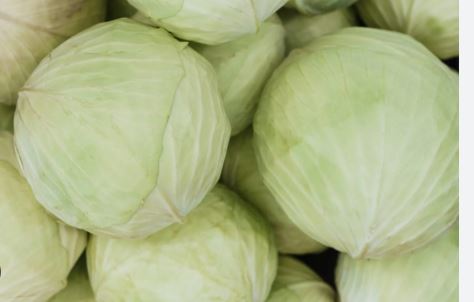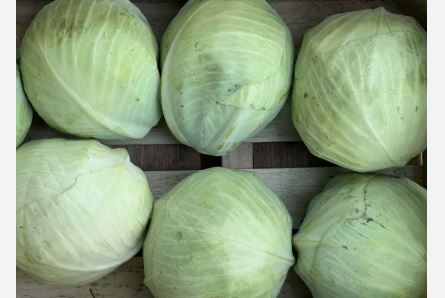
Botanical Classification
White cabbage, scientifically classified as Brassica oleracea var. capitata f. alba, is a member of the Brassicaceae family, which includes cruciferous vegetables such as broccoli, kale, and cauliflower. This cultivar is a type of head cabbage, closely related to green and red cabbage, but distinguished by its pale, almost white leaves.
Like other Brassica oleracea varieties, it descends from wild cabbage native to coastal Europe, with its tight, round heads resulting from centuries of selective breeding within the species.
Origin and History
White cabbage likely originated in Northern Europe, with cultivation records tracing back to the Roman era, though it became more prominent in medieval Europe, particularly in Germany, Poland, and the Netherlands. It was bred for its dense, pale heads, which store well through harsh winters, making it a vital food source in colder climates.
Known in some regions as Dutch cabbage due to its popularity in the Netherlands, it spread globally through trade and colonization. Today, white cabbage is a staple in many cuisines, especially in Eastern Europe and Asia, valued for its durability and versatility.
Identifying Characteristics

White cabbage is characterized by its compact, round heads of smooth, waxy leaves that are pale green to nearly white, giving it a distinct, almost creamy appearance. The heads are dense, typically weighing 2–6 pounds, with tightly packed leaves that are thicker and tougher than those of savoy or bok choy.
The outer leaves are slightly darker and more robust, while the inner leaves are tender and crisp, ideal for both raw and cooked preparations. Its firm texture and pale color distinguish it from other cabbage varieties.
Taste
White cabbage has a mild, slightly sweet flavor with a subtle peppery bite, similar to green cabbage but less intense. When raw, it offers a crisp, crunchy texture, while cooking softens it, bringing out a smoother, sweeter profile.
Its understated taste makes it a versatile base for dishes, absorbing flavors from seasonings, sauces, or other ingredients. Cooler growing conditions enhance its sweetness, and fermentation, as in sauerkraut, adds a tangy complexity to its flavor.
Seasons/Availability
White cabbage is a cool-season crop, available year-round in many regions due to its excellent storage capabilities and cultivation in varied climates. Its peak season in the Northern Hemisphere is late summer to early winter (August–December), with optimal flavor in fall when cooler temperatures improve sweetness.
It tolerates light frost, which enhances its taste, and is widely available in supermarkets, farmers’ markets, and grocers, particularly in temperate regions, with stored cabbages extending availability into spring.
Culinary Uses
White cabbage is a culinary staple, used in a wide range of dishes across cultures. Raw, it’s shredded for coleslaws, salads, or garnishes, valued for its crunch and ability to pair with creamy or tangy dressings.
Cooked, it’s featured in soups, stews, stir-fries, and braises, where it softens and absorbs flavors from ingredients like onions, bacon, or spices. It’s a key ingredient in fermented foods like sauerkraut and kimchi, and in Eastern European cuisines, it’s used in stuffed cabbage rolls or bigos. Its durability also makes it suitable for long-cooked dishes or pickling.
Nutritional Value
White cabbage is a low-calorie, nutrient-dense vegetable, providing about 25 calories per cup. It is an excellent source of vitamin C, an antioxidant that supports immune health, and vitamin K, essential for blood clotting and bone health.
It also offers dietary fiber for digestive health, folate for cell function, and small amounts of manganese, vitamin B6, and potassium. As a cruciferous vegetable, it contains glucosinolates, compounds linked to potential cancer-fighting properties, and antioxidants that reduce inflammation, making it a valuable addition to a balanced diet. Its high water content further aids hydration.
Cultivation of White Cabbage
- Climate Requirements: White cabbage thrives in cool, temperate climates with temperatures between 45°F and 75°F (7°C–24°C). It tolerates light frost, which enhances sweetness by converting starches to sugars, but prolonged exposure below 20°F (-6°C) may damage plants. High temperatures above 80°F (27°C) can lead to bolting or loose heads, making it ideal for spring or fall planting in most U.S. regions, targeting late summer to early winter harvests (August–December).
- Soil Preferences: This cabbage grows best in fertile, well-drained loamy soil with a pH of 6.0–7.5. Incorporate organic matter, such as compost or well-rotted manure, to improve soil fertility and water retention. Good drainage is crucial to prevent root rot, and maintaining a neutral pH ensures nutrients like nitrogen and phosphorus are available for forming dense, pale heads.
- Planting Time: In the U.S., sow white cabbage seeds in early spring (February–March) for a late spring to early summer harvest, or in late summer (July–August) for a fall to early winter harvest. Start seeds indoors 6–8 weeks before the last frost or sow directly when soil temperatures are 50°F–70°F (10°C–21°C). Transplants should be set out when seedlings are 4–6 inches tall.
- Seed Selection: Select high-quality seeds of white cabbage varieties like ‘Copenhagen Market’, ‘Dutch Flat’, or ‘Late Flat Dutch’ for disease resistance, uniform heads, and storage quality. Choose varieties suited to your region’s climate and growing season length. Fresh seeds from reputable suppliers ensure better germination rates, as older seeds may have reduced viability.
- Spacing and Planting: Space plants 12–18 inches apart in rows 24–36 inches apart to allow for large, dense heads to develop. Plant seedlings at the same depth as their nursery pots, firming soil around roots to ensure stability. Adequate spacing promotes air circulation, reducing disease risk, and ensures sufficient light for tight head formation.
- Watering Needs: Provide consistent moisture, delivering 1–1.5 inches of water per week, adjusted for rainfall. White cabbage requires even watering to prevent head splitting or cracking, especially during head development. Avoid waterlogging, which can cause root rot, and use drip irrigation or soaker hoses to keep soil moist without wetting foliage, minimizing fungal issues.
- Fertilization: White cabbage is a heavy feeder, requiring a balanced fertilizer (e.g., 10-10-10) at planting to support early leaf growth. Side-dress with nitrogen-rich fertilizer, such as ammonium sulfate or compost tea, 3–6 weeks after transplanting and again when heads start forming. Avoid late-season nitrogen to prevent excessive leaf growth over head development.
- Pest Management: Watch for pests like cabbage worms, aphids, and cabbage root maggots. Use floating row covers to block egg-laying insects, hand-pick caterpillars, or apply organic controls like neem oil or Bt (Bacillus thuringiensis). Companion planting with herbs like thyme or introducing beneficial insects like ladybugs can help manage aphid populations naturally.
- Disease Control: White cabbage is prone to fungal diseases like clubroot, black rot, and alternaria leaf spot, particularly in wet or poorly drained soils. Practice crop rotation every 3–4 years, maintain soil pH above 6.0, and ensure good drainage to reduce disease risk. Remove infected plant debris and choose resistant varieties to minimize issues, using fungicides as a last resort.
- Weed Control: Eliminate weeds, which compete for light, water, and nutrients, through regular hand-weeding or hoeing. Apply organic mulch, such as straw or wood chips, to suppress weeds, retain soil moisture, and regulate soil temperature. Mulching also reduces erosion and supports healthy root systems, especially during early growth stages.
- Support and Pruning: White cabbage forms dense heads and typically doesn’t need staking, but hilling soil around the base can stabilize plants in windy conditions. Remove yellowing or damaged outer leaves to improve air circulation and reduce pest and disease habitats. Minimal pruning is required, but trimming lower leaves can enhance head appearance and focus plant energy on head formation.
- Harvesting: Harvest white cabbage when heads are firm and reach 2–6 pounds, typically 70–100 days after transplanting, depending on variety. Cut heads at the base with a sharp knife, leaving a few outer leaves for protection or potential regrowth in mild climates. Harvesting after a light frost can improve sweetness, but avoid delays to prevent splitting or toughening.
- Post-Harvest Care: Store white cabbage in a cool, humid environment (32°F–40°F, 0°C–4°C) with 90–95% humidity for up to 4–6 months, one of the longest storage periods among cabbages. Wrap heads in plastic or store in perforated bags to maintain freshness and prevent wilting. For extended harvests, stagger plantings every 2–3 weeks during the planting season to ensure a steady supply.